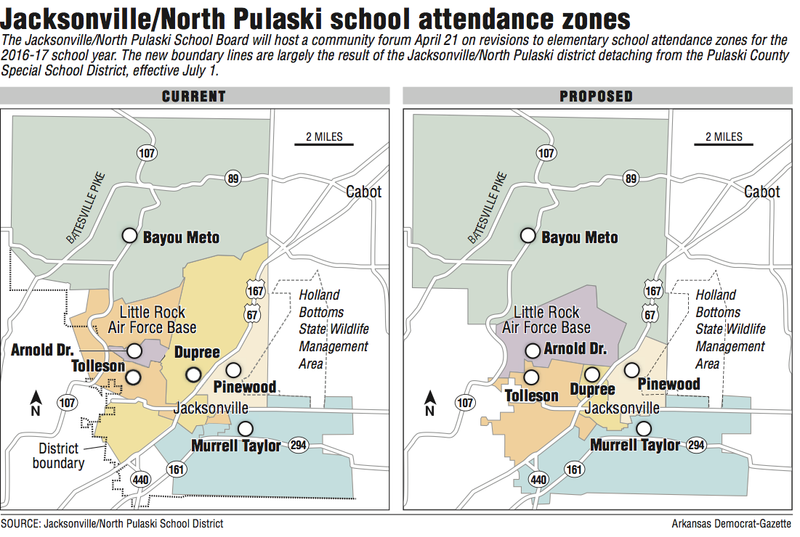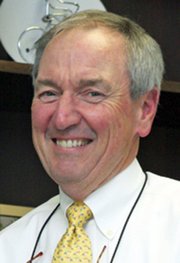The enrollments of six elementary schools in the new Jacksonville/North Pulaski School District will range from 200 to 460 pupils in the 2016-17 school year if the School Board approves revised attendance-zone lines next month.
Superintendent Tony Wood and his staff have introduced a revised plan of school-attendance zones that will result in school assignment changes for 380 or more of the 2,114 pupils the district expects to enroll in the new school year.
The district will hold a public forum on the attendance-zone changes from 6 to 7 p.m. April 21 at the Jacksonville Police Department, 1400 Marshall Road.
"We would anticipate and hope to come back to you May 2 and recommend that this be approved -- if it is appropriate and workable and after we have had public comment," Wood told the School Board this week, adding that the time frame is tight for accomplishing the student-assignment plan and myriad other tasks for opening a new district.
"It's pretty scary to think that this is April," Wood said. "August is going to be here -- just bam! This airplane has got to lift off the runway."
The expected changes in the attendance zones and in school assignments for some pupils are the result of the new Jacksonville/North Pulaski School District being carved out of the Pulaski County Special School District.
Voters in the Jacksonville area -- including some territory outside the Jacksonville city limits -- voted overwhelmingly in September 2014 to form a new school district.
The Arkansas Board of Education ordered the establishment of the district in November 2014 but also directed that the new district remain under the control of the Pulaski County Special district for up to two years to accommodate the districts' planning for the division of students, employees, assets and liabilities.
The new district will detach from the Pulaski County Special district and operate on its own starting July 1.
Some children who have been attending Jacksonville-area schools but don't live within the boundaries of the new district will be reassigned to schools in the remaining Pulaski County Special district.
And then there are some 230 students who reside in Jacksonville but attend schools elsewhere in the Pulaski County Special district. They will be reassigned to schools in their resident district -- Jacksonville/North Pulaski.
Still to be decided officially is whether the new district will grant "permits" enabling students who live in one attendance zone to attend school in another zone.
That is a matter that the School Board will have to decide, Phyllis Stewart, the district's chief of staff, has said.
School Board President Daniel Gray has said he would support allowing pupils to be "grandfathered" into attending their current Jacksonville-area schools, if space is available and a majority of the board agrees.
The board already has decided that the Jacksonville/North Pulaski district will not allow student transfers back and forth across school district lines in the coming school year. To that end, the district has claimed an exemption from the terms of the Public School Choice Act of 2015 that allows interdistrict transfers with some restrictions.
The Jacksonville/North Pulaski district board's policy states that the district is under an enforceable desegregation court order and, as a result of that order, the district is exempt from the provisions of the state's school-choice law.
"The exemption prohibits the District from accepting any school choice applications from students wishing to transfer into or out of the district through standard School Choice," the Feb. 1 policy of the district states.
The Jacksonville/North Pulaski district is a new party in a long-running Pulaski County school desegregation lawsuit and must meet the same desegregation obligations that are outstanding in the Pulaski County Special district.
Both districts are unitary -- or desegregated -- on the issue of student assignments to schools but remain under court supervision to meet requirements regarding equitable school campuses, student discipline, staffing, student achievement and their own desegregation monitoring.
Wood in an interview acknowledged that the two districts are unitary in regard to student assignments but he questioned what the ramifications would be for the Jacksonville district in the ongoing lawsuit if the district participated in school choice to the point that there might be racial segregation of students.
"I don't think it would be wise to explore that," Wood said. "I am very comfortable with what we have chosen to do," he said about taking the exemption to the school-choice law.
If the Jacksonville/North Pulaski elementary school-zoning plan is adopted as proposed, the Warren Dupree, Tolleson and Arnold Drive zone boundary lines would be the most significantly altered.
The student count change would be greatest at Bayou Meto Elementary, where the district projects the enrollment to increase from 289 this year to 452 next year. Bayou Meto would surpass Pinewood, which is currently the largest elementary in the area, and Bayou Meto would closely approach the student count at Murrell Taylor, which is projected to enroll 460 pupils, an increase from 421 currently.
Tolleson's enrollment is projected to decrease from 308 this year to 207 next year. Arnold Drive, a school on Little Rock Air Force Base, is projected to have 200 pupils, down from the current 213.
District staff members worked with Metroplan, a central Arkansas planning agency, to develop the attendance-zone changes. Population distribution, building capacity, racial makeup, and space needs for academic programs and student services were among the factors considered in that work, Wood said.
None of the six schools is projected to reach capacity.
The racial composition of the schools is projected to range from 21 percent black and 79 percent white or other at Bayou Meto to 71 percent black and 29 percent white or other at Murrell Taylor.
The differences in racial makeup among most of the schools are projected to narrow after the district completes the construction of a new elementary school to replace Arnold Drive and Tolleson elementaries.
Tolleson is projected to have a 69 percent black and 31 percent white enrollment next year while Arnold Drive is projected to have a 23 percent black and 77 percent white enrollment. When the new school opens, the 407-student enrollment is projected to be 46 percent black and 54 percent white or other. Bayou Meto will continue to have a largely white enrollment.
The district will not have multiple attendance zones for middle and high schools as the new district will have one middle school and one high school, each of which will serve all students in the district.
A Section on 04/06/2016


